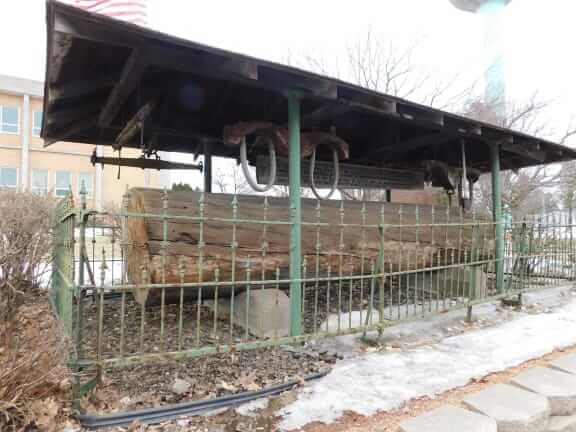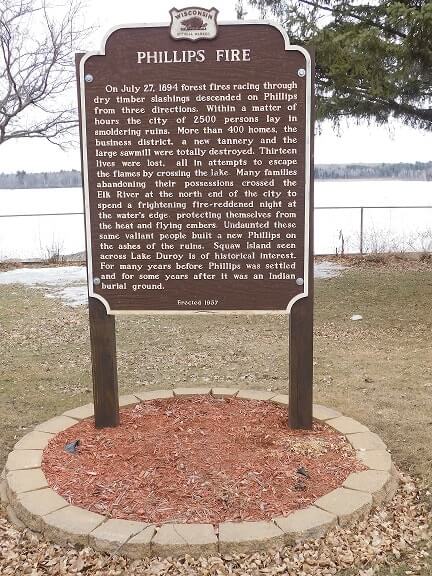As the railroads and the lumber companies made their way through the northern pineries, Phillips grew along the eastern bank of Elk Lake on the Elk River. Never to be the home of the wealthy lumber barons or the scene of the great log drives, Phillips was known as a pleasant, friendly and progressive community, very much as it is today.
The pride with which the city was rebuilt after the fire of 1894 is still evident in many downtown buildings. Nearly one third of the buildings along the main street were built between 1894 and 1900, most of red brick, several with sandstone trim. Efforts to stabilize and modernize have disguised the majority of these architectural gems, but their grace is still evident in their lines and window spacing.

As the timber played out, farmers, mostly Eastern Europe, bought the cut over land, built fine rock fences and raised their families. Downtown Phillips catered to their needs for hardware, dry goods and groceries, filling the gaps on main street with wood frame storefronts. Most businesses had at least one clerk who spoke Czech, and St. Mary’s Catholic Church held service in both Bohemian and English.
Phillips is surrounded by flowages created by logging dams which were rebuilt in the 1930’s under WPA. Over 500 miles of snowmobile trails, 70 miles of cross country ski trails and ample public access for hunting and fishing provide great year around recreation. We also enjoy a strong industrial base with unequalled employment opportunities; a beautiful indoor community pool; and a fine library, all of which make Phillips a great place to live.

Phillips Fire - 1894
The summer of 1894 was one of intense heat and continued drought. By mid-July the timber slashings were tinder dry. Tops and branches of untold numbers of trees were lying in weathered heaps. Thousands of cords of hemlock bark were piled in the woods waiting to be hauled to the tannery. Added to this were the neglected hemlock trunks and the inches of dry needles covering the dusty soil. The streams were nearly dry and the lakes showed muddy flats surrounded by pools of stagnant water. Parched swamps stood high with dry, brown grass replacing the lush green of other years. The stage was set in northern Wisconsin for the worst fires the state would ever see.
Phillips was located in the middle of this powder keg. A thriving sawmill city of 2,500, it was stretched along the west bank of Elk Lake and the Elk River.
July 27th dawned gray and sunless.The brownish-gray haze thickened as the day progressed. Phillips was experiencing another smoky Friday. The mill whistles blew, and work started as usual. Fires had been smoldering in the surrounding cutover for days and the smoke-laden air was something that had to be lived with. Only the night before, a fire had approached the north end of the city, but the efficient volunteer fire department had stopped it. What could not be seen through the wall of smoke, and was not known until too late, was that the fire that would destroy Phillips was already on its way, burning its way towards Phillips from the west.
Fire had started in piles of hemlock bark 10 miles west and was devouring its way, slowly but surely, waiting only for a wind that would change its consuming pace into a racing, roaring giant of destruction.
Shortly after noon, a southwesterly wind sprang up. Soon ashes and burning sparks began to fill the air. Cedar-shingled roofs of houses and the numerous barns were ignited by the sparks. Frantic water pail brigades did what they could to stop the spread of these flames. Then the fire itself, racing in from the west, broke out of the timber near Tannery-town. Despite efforts of the fire department and workmen from the mill and the tannery, the fire roared on unchecked. The wall of fire could not be stopped. Thirty minutes later the tannery, and 25 nearby houses were gone.
Now another fire came out of the swamp near the center of the city, west of the business district. It headed unerringly toward the high piles of lumber and logs waiting on the shore of the lake. On its way, homes and churches, schools and stores, saloons and warehoused, added their bit to the flames.
The residents of Phillips, living in the threat of fire for days, were nevertheless unprepared for the speed of the destruction. When the residents realized that the homes and businesses couldn’t be saved, they tried to save their personal possessions, only to abandon them when flames and flying embers turned all efforts into a race for life. Man could do no more.
Before dawn of the following day a drizzle of rain started to fall. Daylight revealed the most desolate scene imaginable. Only a few charred remnants of building remained. This was utter destruction, which had literally wiped Phillips from the face of the earth.
More information about the history of this area can be found on the Price County Historical Society website.
